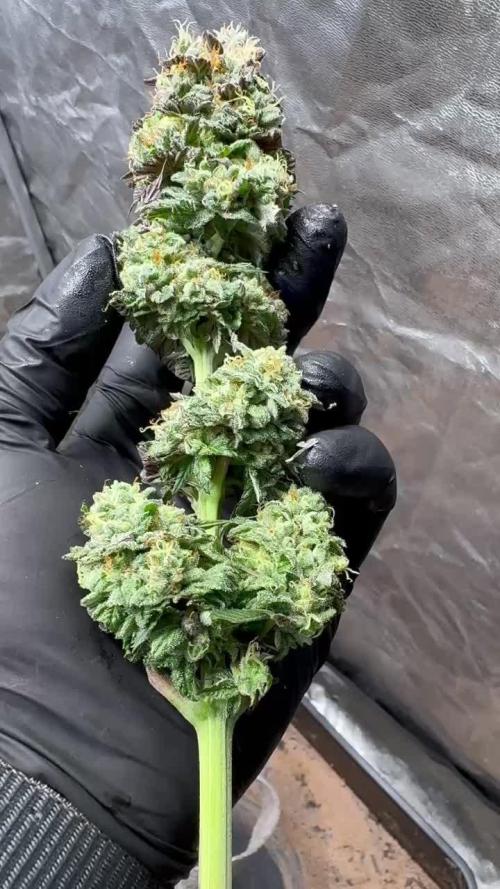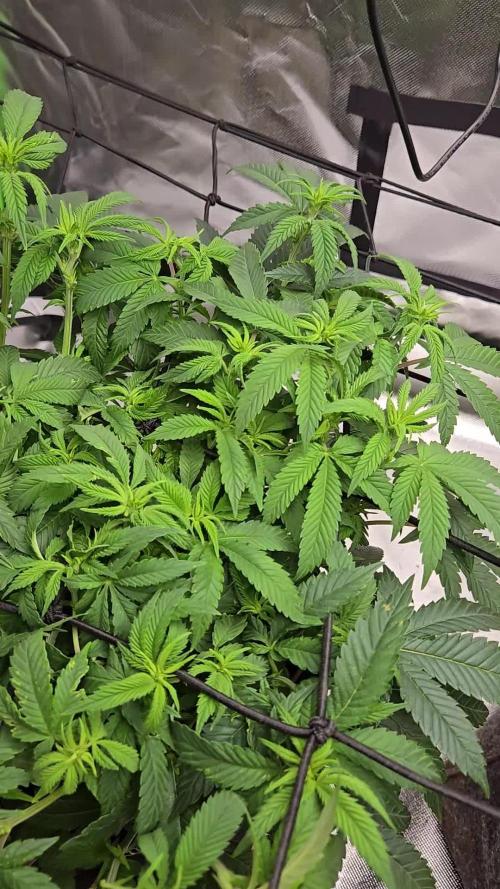The Grow Awards 2026 🏆 



























Likes
Comments
Share


@JUNGLE_B4RNS
Follow
End of week 6 of flowering
Jackpot crop 🤑🤑🤑
All plants did very well, not even one shitty plant growing fluffy buds neither any degenerate plants turning into an endless Sativa. Even the Grape Kush (not registered, only had enough place for 8 different strains) from The Cali Connection did very well.
Cellmax nutrients did a very good job, as always !
Mars-Hydro grows hard dense big fat buds !
The seeds are all coming from highly trusted seeds bank, you can blindly trust these companies whatever the strain you choose from their catalog !
Some plants are nearly done and have entered their senescence since last week. Others might need another 2 weeks max.
Likes
18
Share


@Wrongholn519
Follow
I'm pretty much on auto pilot at this point.. im still just feeding compost extracts to keep it simple. There's a couple things I want to point out this week; I've also included a video of my cheese auto and no extra cost to the reader 😅🤣
PROCESS/ENVIRONMENT CHANGES
- I've lowered the temp inside my tent a little bit to help keep my VFD between a good range for flower (1.0 - 1.5). I also changed the RH on my humidity controller when the temperature goes down after the lights go off. It's kind of a hassle but it's the only way I can stay in the range I'm looking for.
- I've started to raise the pH of my water slowly... I want it to be between 6.6. And 6.8 at this point.
- I've increase all my lights.. my Sf4000 is at 85% intensity and both my Ts1000s are sitting at around 75% intensity.
- I've increased all my fans running. My intake is maxed out, my exhaust is on '6' and my fans inside my tent are all maxed out.. the cheese auto is drowning my entire house out hahaha its crazy.
-I've cut off a whole bunch of fan leaves, larf, bottom branches and a bunch of other unwanted stuff.. I'm hoping that she thickens up fairly like some of her sister's in the tent 🤞 cutting off all the unwanted junk might help at least move more air at the bottom of the canopy.. at most it will help direct energy to other parts of the plant therefore producing a better flower. If she does fill out I'll have to support her side branches so they don't fall over.
- Every day I rotate the plants in my tent so that the get to experience the light in different ways.
Add me on IG for more updates @Wrongholn519
Likes
51
Share


@Corwinism
Follow
WEEK 9 - (04/25/2021 - 05/01/2021)
Day 67 (Week 1, Day 1 - FLOWER): 04/25/2021
Today marks the first official day of the flower cycle. Light timer has been adjusted to 12/12. First 12 hour dark period begins at 5 a.m. on the morning of 04/26. I would say 70-75% of the first screen has been filled.
½ strength nutrient feeding today.
Tap water: 220ppm, 8.2 pH, 70℉
+ FF Grow Big: 5ml/gallon = 45ml/9 gallons
+ FF Big Bloom: 7.5ml/gallon = 75.5ml/9 gallons
+ FF Tiger Bloom: 5ml/gallon = 45ml/9 gallons
+ FF Cal-Mag: 2.5ml/gallon = 22.5ml/9 gallons
+ Fish Shit: 2ml/gallon = 18ml/9 gallons
+ HydroGuard: 1ml/gallon = 9ml/9 gallons
+ pH Down: 14ml (6.5 pH before adding)
Mixture: 910ppm, 6.1 pH, 70℉
ppm/ppm = runoff/soil
JB#1 - 1510ppm/600ppm, 5.8 pH
JB#2 - 1530ppm/620ppm, 5.7 pH
AP#1 - 2500ppm/1590ppm, 5.7 pH
AP#2 - 2260ppm/1350ppm, 5.8 pH
GC#1 - 2490ppm/1580ppm, 5.8 pH
GC#2 - 2510ppm/1600ppm, 5.7 pH
-------------------------------------------------------------------------------------------------------------------------------------------
Day 71 (Week 1, Day 5 - FLOWER): 04/29/2021
Watered plants today. Glookies #1 gave off a really high ppm reading. Don’t think it was accurate.
Tap water: 220ppm, 8.7 pH
+ HydroGuard: 1ml/gallon = 9ml/9 gallons
+ pH Down: 28ml
Mixture: 230ppm, 6.2 pH, 68℉
ppm/ppm = runoff/soil
JB#1: 1320ppm/1090ppm, 6.7 pH
JB#2: 1115ppm/885ppm, 6.5 pH
GC#1: 3540ppm (seems too high)
GC#2: 2270ppm/2040ppm, pH 6.5
AP#1: 2410ppm/2180ppm, 6.4 pH
AP#2: 1600ppm/1370ppm, pH 6.6
Well, the first week of flower is in the books. All but one plant is starting to grow pistils. These plants are getting a little out of control being cramped in this 4x4. I defoliated just before flipping to flower, and they needed another touch-up. I'm a little worried this will cause me to have to do frequent touch-ups or kill one or two plants and create some space. I'm leaning more toward killing 1 or 2 plants, rather than risk all of them getting overly stressed from too many defoliations. I completely underestimated how much these Cannabis plants would grow, especially once they started to stretch.
I'm going to start saving the water that is collected through the dehumidifier. The plan is to use this water for the flush in the last 2 weeks of flower.
Thanks for dropping in and showing some Aloha, everybody. And remember, don't drink and drive, smoke and fly. See you next week. 🙏
Likes
9
Share


@Jofflepov
Follow
Looking for optimal led height.
RQS' Northern Lights auto and Diesel auto look very sophisticated and detailed. They are standing in the middle. Rest of the plants are auto lemon Hazes and they have may varieties. Two are growing very fast and two are stunted.
At least one more week of indoor growing before going outside in a bigger pot.
Likes
1
Share


@Ninjabuds
Follow
It's been a great week for the seedlings! They've really taken off and are looking strong. I'm planning to transplant them into larger pots in the next few days, so next week's photos should show some impressive growth. I'm so excited to see how they thrive in their new homes! I've been giving them distilled water from the start, and I'm still doing that, but I just started adding 10 milliliters of Fox Farm Big Bloom and 1 milliliter of Fox Farm Grow Big. All of the seedlings are doing really well, and there's not really any visible difference between all the ten strains. I started all ten packs of each strain and kept all the best seedlings, so that's why they're all doing so well.
Likes
96
Share


@Tropicannibis_Todd
Follow
💩Alrighty then Growmies We Are Back At it 💩
Well folks we just finished up the last run and so we are bad to do it all over again 😁
So what do you say we have some fun 👈 We got some Z & Z 🚗 🚘 🚗 🚘 👉 From Exotic Seeds
I had to keep up with the Humidity by boiling some water in conjunction with my Humidifier its been ruff but doable 👌
It's been a great first week so I'm happy with what I got going on so far👌
FC4800 from MarsHydro Lights being readjusted and chart updated .........👍I've added a UR45 to the mix👈
www.marshydro.ca
👉I used NutriNPK for nutrients for my grows and welcome anyone to give them a try .👈
👉 www.nutrinpk.com 👈
NutriNPK Cal MAG 14-0-14
NutriNPK Grow 28-14-14
NutriNPK Bloom 8-20-30
NutriNPK Bloom Booster 0-52-34
I GOT MULTIPLE DIARIES ON THE GO 😱 please check them out 😎
👉THANKS FOR TAKING THE TIME TO GO OVER MY DIARIES 👈
Likes
8
Share


@Growtopus
Follow
261 g nass ist für die Umstände total in Ordnung. Der Schädlingsbefall hat sie in der Vegi ordentlich gestört und eigentlich sollten es ja zwei Pflanzen sein. Dazu war das Licht einfach viel zu stark eingestellt und hat sie zusätzlich gestresst.
Jetzt wird erstmal getrocknet in DryFerms die ich noch da hatte.
Trocken 80 g, jetzt fehlt noch das Curing.
Likes
17
Share


@BudBrewerz
Follow
Very dense buds, the most dense I ever had .... I think .... They are ubersticky and have a super intense sweet smell (that covers the entire house by now 🤭👃) Really happy with this one... Could be one of my best outcomes in a very long time... Could be forever
Likes
9
Share


@xmackobox
Follow
Semillas regulares Alioli de Dr. Ganjah
Simplemente alucinante la calidad a pesar del pesimo cultivador xd
Likes
13
Share


@MrGrowDiarie
Follow
Day 77
The canopy has really filled in nicely - the plant looks healthy, bushy, and well-trained. The SCROG net is doing its job perfectly, keeping the tops even and encouraging strong horizontal growth. Leaves are a deep, healthy green with no visible nutrient burn or deficiency. Growth appears balanced and vigorous.
Likes
10
Share


@Barzenegger
Follow
Since the GMO seems to be getting more and more spots and is losing color, I decided to up the nutes a bit and also buy a few more Canna products.
The buds started swelling so I thought it's a good time to try Canna Boost and PK 13/14.
Likes
41
Share


@bypado_farm
Follow
Day 63:
Watered the plants 0.5L with nuts, 4L total, 919 ppm, 1955 us/cm, PH 6.4
Day 65:
Watered the plants 0.5L with nuts, 4L total, 780 ppm, 1661 us/cm, PH 6.4
Day 67:
Watered the plants 0.5L with nuts, 4L total, 729 ppm, 1563 us/cm, PH 6.4
Day 69:
Watered the plants 0.5L with nuts, 4L total, 905 ppm, 1925 us/cm, PH 6.4
Next irrigation's without nuts, flushing next week
1 plant with foxtails (good ones)(small too)
Likes
22
Share


@HydroHerb420
Follow
Wish I could have vegged the clones another couple of weeks but the Zkitzo was just growing to fast. In hindsight shouldn’t have put a plant from seed in with the clones. Seeds always grow like mad in NFT and clones are more manageable as they don’t have a tap root. Still got some absolutely beautiful looking and smelling bud from the Zkitzo so can’t really regret it. The Gelatos are rock solid right through and look absolutely beautiful. Used rainwater right the way through on this so should smoke nice to. Better pictures as it dries.
Likes
1
Share


@Nvchods3
Follow
hace tiempo tenia ganas de cultivar esta cepa, de buen crecimiento y aroma dulce.
muy buena produccion de cogollos y resina,
resistio muy bien algunos problemas al inicio del cultivo en la poda apical y posterior LST, buena cepa para LST muy frondosa





























